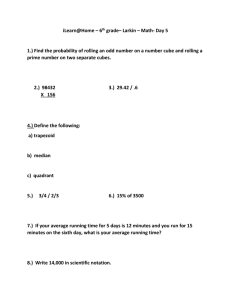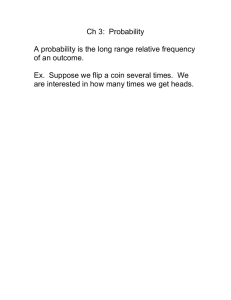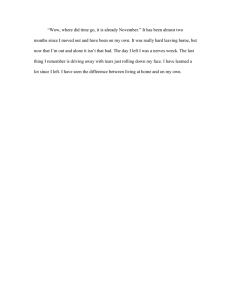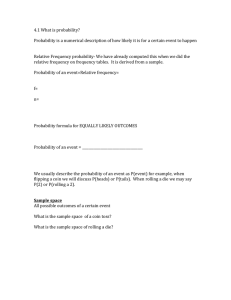Effect of Stretch Orientation and Rolling Orientation on the
advertisement
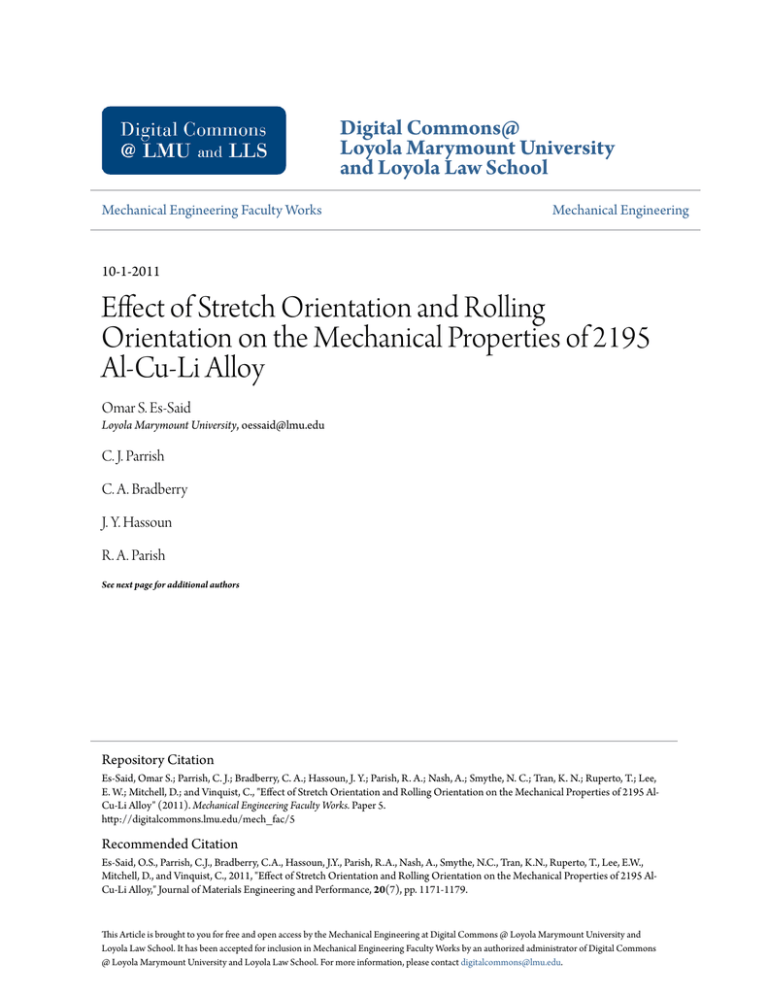
Digital Commons@
Loyola Marymount University
and Loyola Law School
Mechanical Engineering Faculty Works
Mechanical Engineering
10-1-2011
Effect of Stretch Orientation and Rolling
Orientation on the Mechanical Properties of 2195
Al-Cu-Li Alloy
Omar S. Es-Said
Loyola Marymount University, oessaid@lmu.edu
C. J. Parrish
C. A. Bradberry
J. Y. Hassoun
R. A. Parish
See next page for additional authors
Repository Citation
Es-Said, Omar S.; Parrish, C. J.; Bradberry, C. A.; Hassoun, J. Y.; Parish, R. A.; Nash, A.; Smythe, N. C.; Tran, K. N.; Ruperto, T.; Lee,
E. W.; Mitchell, D.; and Vinquist, C., "Effect of Stretch Orientation and Rolling Orientation on the Mechanical Properties of 2195 AlCu-Li Alloy" (2011). Mechanical Engineering Faculty Works. Paper 5.
http://digitalcommons.lmu.edu/mech_fac/5
Recommended Citation
Es-Said, O.S., Parrish, C.J., Bradberry, C.A., Hassoun, J.Y., Parish, R.A., Nash, A., Smythe, N.C., Tran, K.N., Ruperto, T., Lee, E.W.,
Mitchell, D., and Vinquist, C., 2011, "Effect of Stretch Orientation and Rolling Orientation on the Mechanical Properties of 2195 AlCu-Li Alloy," Journal of Materials Engineering and Performance, 20(7), pp. 1171-1179.
This Article is brought to you for free and open access by the Mechanical Engineering at Digital Commons @ Loyola Marymount University and
Loyola Law School. It has been accepted for inclusion in Mechanical Engineering Faculty Works by an authorized administrator of Digital Commons
@ Loyola Marymount University and Loyola Law School. For more information, please contact digitalcommons@lmu.edu.
Authors
Omar S. Es-Said, C. J. Parrish, C. A. Bradberry, J. Y. Hassoun, R. A. Parish, A. Nash, N. C. Smythe, K. N. Tran,
T. Ruperto, E. W. Lee, D. Mitchell, and C. Vinquist
This article is available at Digital Commons@
Loyola Marymount University
and Loyola Law School: http://digitalcommons.lmu.edu/mech_fac/5
ASM International
1059-9495/$19.00
JMEPEG (2011) 20:1171–1179
DOI: 10.1007/s11665-010-9746-6
Effect of Stretch Orientation and Rolling Orientation
on the Mechanical Properties of 2195 Al-Cu-Li Alloy
O.S. Es-Said, C.J. Parrish, C.A. Bradberry, J.Y. Hassoun, R.A. Parish, A. Nash, N.C. Smythe, K.N. Tran, T. Ruperto,
E.W. Lee, D. Mitchell, and C. Vinquist
(Submitted April 30, 2010; in revised form August 2, 2010)
Sheets of 2195 aluminum-lithium alloy were solution-treated at 507 °C for 30 min. One set was stretched to
3-5% in the 0°, 45°, and 90° angle with respect to the original rolling direction. Two other sets were rolled
6% reduction in thickness and 24% reduction in thickness in the 0°, 45°, and 90° angle with respect to the
original rolling direction. All specimens were aged at 143 °C for 36 h. A second group of samples was rolled
at 24 and 50% reduction in thickness after a solution treatment of 507 °C for 1 h prior to aging at 190 °C
for 24 h. Tensile specimens were machined from each sheet at 0°, 45°, and 90° angles to the original grain
orientation. Tensile testing was used to determine the mechanical properties and anisotropic behavior of
each condition. Rolling 6% reduction in thickness in the 45° orientation yielded anisotropy of 7.6% in the
yield strength.
Keywords
2195 Al-Li, anisotropy, rolling orientation, stretch
orientation
1. Introduction
Aluminum-lithium 2195 is of great interest to the aerospace
industry due to its superior physical and mechanical properties.
It offers an improvement over the conventional 2219 alloy with
an increased strength of 30-40% and a reduced density of 5%
(Ref 1, 2). It was actually used in the fabrication of the super
lightweight external tank of the Space Transportation System,
NASAÕs mission STS-91. It provided a mass reduction of over
3000 kg and 50% increase of the payload capability (Ref 1-6).
Much research has been done on this alloy system. Li et al.
(Ref 1) studied the effects of stretch prior to aging on the
mechanical properties of the 2195 alloy. Hall and Sisk (Ref 7)
studied the effects of reversion aging, Langan et al. (Ref 8)
researched the environmentally assisted cracking and localized
corrosion susceptibility, Hou et al. (Ref 9). Thompson (Ref 10),
Bastias et al. (Ref 11), and Diwan et al. (Ref 12) researched the
effects of welding, and Dyer et al. (Ref 13) studied the effect of
near-net forging, Jiang et al. (Ref 4) studied the microstructure
evolution of the 2195 alloy undergoing commercial production
and Hales and Hafley (Ref 14) studied the structure-property
correlations of the 2195 alloy in integrally ‘‘T’’ stiffened
extruded panels.
O.S. Es-Said, C.J. Parrish, C.A. Bradberry, J.Y. Hassoun,
R.A. Parish, A. Nash, N.C. Smythe, K.N. Tran, T. Ruperto,
D. Mitchell, and C. Vinquist, Department of Mechanical Engineering,
Loyola Marymount University, Los Angeles, CA 90045-8145; and
E.W. Lee, Naval Air Warfare Center, Code 4342, MS, Bldg. 2188,
Patuxent River, MD 20670-1908. Contact e-mail: oessaid@lmu.edu.
Journal of Materials Engineering and Performance
As with most aluminum-lithium alloys, one of the major
concerns associated with the 2195 alloy is the mechanical
strength anisotropy, (Ref 15, 16). The origin of anisotropy
results from interactions among crystallographic texture, grain
size and shape, cold deformation, and the precipitates developed during aging. This anisotropic behavior led to the
inclusion of testing data at 45 with respect to the rolling
direction as part of the MIL-HDBK-5 design minimal requirements (Ref 17). The T1 phase (Al2CuLi) is the major source of
strengthening in this alloy system. This precipitate occurs as
plates on {111} planes. Kim and Lee (Ref 18) have shown that
there is an inhomogeneous distribution of the T1 precipitates
among the four {111} habit planes after stretching and aging of
a 2090 aluminum-lithium alloy. It was further reported that this
inhomogeneous distribution had a direct effect on the mechanical anisotropy of the material. Samples pulled at orientations
parallel to the rolling direction had high strength because a high
density of T1 precipitates intercepted the slip plane resulting in
homogenous deformation. Samples pulled at 60 orientation
with respect to the rolling direction were weaker because the
density of the T1 precipitates was lower and were insufficient to
influence the deformation behavior.
Among the methods of reducing the anisotropy of tensile
properties was stretching or cold rolling in different directions,
(Ref 17). Many attempts to minimize the mechanical anisotropy
were successful when off-axis deformation was conducted on
aluminum-lithium alloys (Ref 19-22). The philosophy was that
off-axis deformation would change the morphology of the
dislocation structure which the T1 precipitates nucleate on. The
objective of this study is to further research the effects of stretch
orientation and rolling orientation on the mechanical tensile
properties and anisotropy of the 2195 Al-Cu-Li alloy.
2. Experimental Procedure
The composition of the 2195 Al-Cu-Li alloy used in this
investigation is presented in Table 1 (Ref 23).
Volume 20(7) October 2011—1171
The material was received from Reynolds, Richmond,
Virginia as 0.318-cm thick sheets in the F-temper. Samples
were solution heat-treated at 507 C for 30 min and water
Table 1 Nominal chemical composition of 2195 Alloy
Cu
Li
Ag
Zr
Mg
Al
4.1
1.41
0.4
0.13
0.35
Balance
Fig. 1
quenched. Groups of samples were rolled to 6% reduction in
thickness, 24% reduction in thickness, and stretched 2.5-3.0%
at 0, 45, and 90 angles to the original rolling direction,
respectively. The samples were then aged at 143 C for 36 h
and air-cooled. Tensile specimens were machined from each
sheet at 0, 45, and 90 angles to the original grain orientation.
A flowchart showing the sequence of processing is shown in
Fig. 1.
A second group of samples was solution-treated at 507 C
for 1 h and water quenched. Following the solution treatment,
the samples were cold-rolled either 24 or 50% reduction in
The flow chart of the thermomechanical processing of the 2195 aluminum alloy
Fig. 2 Cold work and machining orientations in relation to original rolling direction. First number: angle of cold work (stretching or rolling) in
relation to original rolling direction, second number: angle of cut tensile sample in relation to original rolling direction
1172—Volume 20(7) October 2011
Journal of Materials Engineering and Performance
thickness in the 0, 45, and 90 directions. Following the
rolling, the samples were aged at 190 C for 24 h and aircooled. The samples were subsequently machined into tensile
specimens at 0, 45, and 90 angles to the original grain
direction and tested in tension. The solution treatment and
aging were similar to those used by Li et al. (Ref 1).
A schematic diagram showing the stretching and rolling and
machining orientations with respect to the original rolling
direction is shown in Fig. 2. In it, for example, a 0-45 sample
means that it is stretched or rolled along the rolling direction
(0) and machined at 45 to the rolling direction.
Tensile specimens were prepared and tested in accordance
with ASTM standard E8. The tensile samples were rectangular
plate specimens, with 203.2 mm (8.0 in) total length, 50.8 mm
(2.0 in) gauge length, 12.7 mm (0.5 in) width, 57.15 mm
(2.25 in) length of reduced section, and 12.7 mm (0.5 in)
radius of fillet. The thickness of the samples was reduced to
6.35 mm (0.25 in). The grips had 50.8 mm (2.0 in) length and
19.05 mm (0.75 in) width. Specimens were machined using
standard milling machines and a CNC machine. Tensile test
was performed on an Instron 4505 test frame at a constant cross
head speed of 1.27 mm/min (0.05 in/min). Three specimens
were tested at each test condition with each data point
representing the mean of three tests.
Fig. 3
3. Results and Discussion
The effect of solution treatment (507 C for 30 min and
water quenching) and the effect of solution treatment and aging
(143 C for 36 h and air cooling) on the yield and tensile
strengths are shown in Fig. 3. The mechanical strengths
increase after solution treatment due to solid solution hardening
and after aging due to the effect of the T1 (Al2CuLi)
precipitates. The yield strength of the aged samples in the 0
direction (354 MPa) is lower than that of the 2195 material
(500 MPa) studied by Li et al. (Ref 1), however, and the
ultimate strengths were comparable (524-537 MPa). The
anisotropy (difference between highest and lowest value/
highest value) also increased with solution treatment and
subsequent aging (7-12.7%).
The effect of stretching 2.5-3% and rolling 6% reduction in
thickness is shown in Fig. 4(a) and (b). Stretching increases the
yield strength slightly while rolling increases it significantly
when compared to the as aged condition, Fig. 3. However, the
ultimate tensile strengths are slightly higher in rolled samples
versus stretched samples, Fig. 4(b). The anisotropy in yield
strength is a minimum (7.6%) after 45 rolling and after 90
stretching (9.5%) which accords with the results of previous
Comparison of yield and ultimate strengths and anisotropies for as-received, solution treated, and aged 2195 alloy
Journal of Materials Engineering and Performance
Volume 20(7) October 2011—1173
(a)
(b)
Fig. 4
Comparison of yield strengths (a) and ultimate strengths (b) for rolling 6% and stretching 2.5-3%
1174—Volume 20(7) October 2011
Journal of Materials Engineering and Performance
work (Ref 21, 24), while 45 stretching maximizes (17.6%) the
anisotropic behavior (Ref 21). The anisotropy in ultimate
strength is higher in stretched samples (13-15%) as compared
to rolled samples (9-11%), Fig. 4(b). Again, the yield strength
of the 2.5-3% stretched material in the 0 direction (378 MPa)
is lower than that reported by Li et al. (Ref 1) (510 MPa),
the ultimate tensile strengths however are comparable (551
MPa).
The effect of increasing the reduction in thickness from 6 to
24% after solution treatment and prior to aging is shown in
Fig. 5(a) and (b). The strength values increased slightly in both
yield and ultimate strengths. However, the anisotropy in yield
strengths is more than doubled from 9-13.7% to 14.8-26%,
Fig. 5(a).
In the study by Li et al. (Ref 1), specimens were solutiontreated at 507 C for 1 h, and quenched in ice water. The
samples were immediately stretched parallel to the rolling
direction (0 orientation) from 3 to 15% prior to aging at
190 C for 24 h. The maximum yield strength after 15% stretch
at (0-0) position (stretched and machined parallel to the original
rolling direction) is 572 MPa and at the (0-90) position
(stretched parallel to the rolling direction and machined
perpendicular to it) is 537 MPa, Fig. 2. The ultimate
strengths are 613 and 579 MPa, respectively. The values
obtained from this study for the (0-0) orientation after rolling
6% are 564 and 615 MPa in yield and in ultimate strengths, and
598 and 665 MPa after 24% rolling, respectively, Fig. 5(a) and
(b). Those obtained for the (0-90) orientation are 538 and
579 MPa in yield and in ultimate strengths after 6% reduction
and 601 and 619 MPa after 24% reduction in thickness,
respectively. The strength values obtained after 6% reduction
are similar to the 15% pre-stretching (Ref 1) while 24% rolling
are significantly superior. The percent elongation of the aged
samples exhibited a constant value of 10% irrelevant of the
amount of pre-stretch for both (0-0) and (0-90) orientations,
(Ref 1). Also, in this study the percent elongation was always
high, Table 2(a) to (d) even after 24% reduction in thickness
prior to aging, Table 2(d). This alloy possesses significant
improvement in ductility as compared to the 2090 and 2095
alloy systems (Ref 21).
An attempt was made to introduce 24 and 50% reduction in
thickness by rolling after 507 C, hour-long solution treatment
and prior to 190 C, 24 h aging. In 24% reduction in thickness
process, many samples were badly curled and could not be
machined, however, in the 50% reduction in thickness process,
samples were straightened and machined into tensile bars. The
results shown in Table 3(A) to (D) clearly indicated the onset of
microcracking and most of the samples fractured outside the
gauge length. It should be noted that applying a rolling
deformation of 24% reduction in thickness to the previous
solution and aging treatments retained the ductility of the
material to high values of percent elongation, Table 2(d).
In a previous study (Ref 25), one group of samples used in
this study was evaluated for crystallographic texture analysis.
Three sets of samples were solution-treated at 507 C for
30 min, water quenched, and rolled to 24% reduction in
thickness in the 0, 45, and 90 directions to the original
rolling direction, aged at 143 C for 36 h (Fig. 5(a) and (b)) and
were used for texture evaluation. Pole figures were generated
and orientation distribution functions (ODF) were derived for
this group as well as for the as-received sample (Ref 25).
The as-received sample exhibited a reasonable amount
of typical FCC rolling texture. The texture indicates a large
Journal of Materials Engineering and Performance
component of Brass {110}Æ112æ texture with an intensity of
209 random. Aluminum-lithium alloys have high intensity of
the brass texture component which is directly proportional to
the degree of mechanical anisotropy (Ref 17). It is not clear
why grains with {110}Æ112æ lead to a high degree of anisotropy
in the aluminum-lithium alloys, (Ref 22). Smaller Copper
{112}Æ111æ and shear {111}Æ112æ components with an intensity
of 59 random were also observed. Recrystallization texture
components of Goss {110}Æ001æ with a texture intensity of
159 random, R {124}Æ211æ 109 random and P {110}Æ122æ
59 random were also apparent in the results. The texture
components are significantly different when compared to those
of the 2095 aluminum-lithium alloy (Ref 22). However, these
components are typical deformation and recrystallization
components present in Al-Li alloys (Ref 26-28).
Figure 6(a) shows the variation in the deformation texture
for the as-received samples and samples rolled 24% reduction
in thickness along the rolling direction (0), and at 45 and 90
directions. The variation in recrystallization texture is shown in
Fig. 6(b). The results indicate that rolling along the 0
orientation produces the largest Brass and Copper components.
Rolling along the 0 direction also produced a relatively large
(109 random) X {110}Æ111æ component and a lesser Rotated
Brass component {110}Æ223æ, 69 random. Rolling along the
90 produced a larger (109 random) Rotated Brass component
than other orientations. The Brass component did not change
(209 random), whereas the Copper was reduced to a minimum
value. Rolling along the 45 resulted in the lowest Brass
component.
Samples rolled at 0 produced higher Brass and Copper
components and are associated with higher yield strength
values, Fig. 5(a) and (b). In contrast, samples rolled at 45
resulted in lower Brass and Copper components and were
associated with lower yield strength values, and samples rolled
at 90 showed large variations in the Brass components and in
the strength values.
These results are not in accord with the results of other
researches (Ref 27, 28). The in-plane anisotropy in tensile
stress is strongly influenced by the intensity of the Brass
texture, {110}Æ112æ. From Fig. 6(a), the Brass intensity is
highest in the samples rolled along the 0 direction followed by
the 90 rolling and the 45 rolling. The latter was expected to
have the least anisotropy; however, it had the highest anisotropy (26.7%) in yield strength, Fig. 5(a).
4. Summary
Aluminum-lithium alloys exhibit strong crystallographic
texture and are typically anisotropic. The anisotropic behavior
of aluminum-lithium alloys during plastic forming is important
and needs to be understood more clearly in all production and
design steps (Ref 29, 30). Anisotropy is caused by several
factors. These include elongated grains and the presence of
second phase particles (Ref 17).
Crystallographic texture results from thermomechanical
treatments like hot or cold rolling or stretching and is most
directly responsible for anisotropy in metals (Ref 29-31). Kim
and Lee (Ref 18) studied the effect of the inhomogeneous
distribution of the T1 plate precipitates (Al2CuLi) among four
{111} habit planes after stretching and aging on the tensile
properties of a 2090 aluminum-lithium alloy. Es-Said and Lee
Volume 20(7) October 2011—1175
(a)
(b)
Fig. 5
Comparison of yield strengths (a) and ultimate strengths (b) for rolled 6% and rolled 24%
1176—Volume 20(7) October 2011
Journal of Materials Engineering and Performance
Table 2 Percent elongations of different conditions
Angle of tensile
testing
AR, %
AR + ST, %
Table 3 Yield and ultimate strengths for rolling 24%
and rolling 50%, solution treatment: 507 °C for 1 h and
water quenched aging: 190 °C for 24 h and air-cooled
AR + ST + AG, %
Angle of cold work
(a) As-received, solution-treated, and aged samples
0
14.1
12.8
45
17.9
32.2
90
14.6
30.8
Angle of tensile testing
20.8
35.4
29.0
(A) Yield strength (MPa) rolled 24%
0
617
45
(a)
90
569
(B) Ultimate strength (MPa) rolled 24%
0
661
45
(a)
90
615
(C) Yield strength (MPa) rolled 50%
0
351
45
532
90
570
(D) Ultimate strength (MPa) rolled 50%
0
387
45
540
90
588
Angle of cold work
Angle of tensile testing
0°, %
a
40
ODF Intensity
(b) Stretched 2.5-3% samples
0
45
90
(c) Rolled 6% samples
0
45
90
(d) Rolled 24% samples
0
45
90
30
45°, %
90°, %
25.4
34.8
28.0
21.6
28.5
23.6
23.0
33.3
24.5
14.7
20.0
12.0
11.7
18.7
16.8
8.4
20.4
11.4
14.0
17.2
13.3
7.0
14.5
12.8
10.3
16.4
5.6
0°
45°
90°
450
501
(a)
613
(a)
430
516
577
(a)
642
(a)
430
254
223
366
617
425
400
553
497
481
633
425
400
(a) All samples were badly curled and unable to be machined into
tensile samples
Brass {110}<112>
Copper {112}<111>
20
Shear {111}<112>
X {110}<111>
10
Rotated Brass {110}<223>
0
AR
0
45
90
Orientation (Degrees)
b
40
ODF Intensity
RCN {001}<013>
RCT {013}<013>
30
P {110}<122>
20
Cube {001}<100>
Goss {110}<001>
10
R {124}<211>
S {123}<624>
0
AR
0
45
90
Orientation (Degrees)
Fig. 6 Variation in texture components for the as-received and rolled in 0, 45, and 90 orientations. Deformation texture components are
shown in (a). The recrystallization texture components are shown in (b) (Ref 16)
(Ref 21) studied the effect of stretching 2095 aluminum-lithium
alloy at different angles with respect to the rolling direction
prior to aging. They also studied the effect of 45 rolling prior
to aging.
Their results (Ref 21) indicated that stretching along the 60
and 90 were more effective than other direction stretches in
Journal of Materials Engineering and Performance
reducing the tensile anisotropy. The 45 rolling prior to aging
was the most effective in reducing the tensile anisotropy. These
results are also confirmed in this study. It appears that off-axis
deformation produces a heterogeneous distribution of the
primary strengthening T1 precipitates on specific habit planes.
It is not clear why a 45 rolling or a 90 stretch would reduce
Volume 20(7) October 2011—1177
the anisotropy. It might be that these off-axis deformations after
aging treatments help produce favorable orientations in the T1
precipitates which prevent planar slip and results in homogenous deformations. A controlled stretch prior to aging is
essential to accelerate precipitation of the strengthening phases
to bring the yield strength to peak age levels (Ref 27); however,
it appears that off-axis deformation has the potential of
significantly reducing anisotropy. Probably these improvements
in mechanical anisotropy will be brought about by the parts
fabricators rather than the mil product producers (Ref 17). A
fundamental study of characterizing the dislocation structure
morphology after off-axis deformation prior to aging in
aluminum-lithium alloys would clarify the origin of reduction
in mechanical anisotropic behavior.
5. Conclusions
1. Solution treatment at 507 C for 30 min and the subsequent aging at 143 C for 36 h increases the strength but
also increases the anisotropic mechanical behavior.
2. Stretching (2.5-3%) and rolling (6%) prior to aging increases the strength values. The anisotropy in yield
strength is a minimum after 45 rolling and 90 stretching and maximum after 45 stretching.
3. Increasing the rolling deformation from 6 to 24% reduction in thickness increases the strength slightly at the expense of increasing the anisotropy significantly, however,
ductility is retained.
4. Applying a rolling deformation of 24% (and 50%) reduction in thickness after a solution treatment at 507 C for
1 h and prior to aging at 190 C for 24 h induced microcracking.
5. The yield strength anisotropy for samples rolled at 24%
reduction in thickness was highest for the 45 rolling,
followed by the 90 rolling, and then by the 0 rolling.
This was in a reverse trend to the increase of the Brass
deformation texture component.
Acknowledgments
This study was funded by the National Science Foundation,
NSF Grant No. EEC-9732046, Research Experience for Undergraduates (REU) site.
References
1. Z.X. Li, R.A. Mirshams, E.A. Kenik, and P.J. Hartley, Effect of
Stretching Prior to Aging on Mechanical Properties in Al-Cu-Li (2195)
Alloy, Light Weight Alloys for Aerospace Applications IV, E.W. Lee,
K.V. Jata, W.E. Frazier, and N.J. Kim, Ed., TMS, Orlando, 1997,
p 117–127
2. E.A. Starke Jr. and B.N. Bhat, Technical Summary, Aluminum-Lithium
Alloys for Aerospace Application Workshop. B.N. Bhat, T.T. Bayles,
and E.J. Vesely, Jr., Ed., December 1994, p 1–2
3. R.J. Schwinghammer, Deputy Director of Space transportation systems, NASA-George C. Marshall space flight center, Opening
Remarks, Alumminum-Lithium Alloys for Aerospace Applications
Workshop. B.N. Bhat, T.T. Bayles, and E.J. Vesely, Jr., Ed., December
1994, p 1–2
4. N. Jiang, X. Gao, and Z.-q. Zheng, Microstructure Evolution of
Aluminum-Lithium Alloy 2195 Undergoing Commercial Production,
Trans. Nonferrous Met. Soc. China, 2010, 20, p 740–745
1178—Volume 20(7) October 2011
5. J.H. Sanders, Investigation of Grain Boundary Chemistry in Al-Li
2195 Welds Using Auger Electron Spectroscopy, Thin Solid Films,
1996, 277(1/2), p 121–127
6. M.C. Chaturvedi and D.L. Chen, Effect of Specimen Orientation and
Welding on the Fracture and Fatigue Properties of 2195 Al-Li Alloy,
Mater. Sci. Eng., 2004, 387(389), p 465–469
7. I.K. Hall and D.B. Sisk, Aluminum-Lithium Alloy 2195 Revision
Aging Study, Aluminum-Lithium alloys for Aerospace application
workshop. B.N. Bhat, T.T. Bayles, and E.J. Vesely, Jr., Ed., December
1994, p 114–120
8. T.J. Langan, P.E. McCubbin, and J.R. Pickens, Environmentally
Assisted Cracking and Localized Corrosion Susceptibility for Aluminum Alloys 2195 and 2219, Aluminum-Lithium Alloys for Aerospace
Applications Workshop. B.N. Bhat, T.T. Bayles, and E.J. Vesely, Jr.,
Ed., December 1994, p 114–120
9. K.H. Hou, W.A. Baeslack III, J.C. Lippold, and A. Szabo, Microstructure Evolution in the Heat-Affected Zone of a Gas Tungsten-Arc
Welded Al-2195, Aluminum-Lithium Alloys for Aerospace Application
Workshop. B.N. Bhat, T.T. Bayles, and E.J. Vesely, Jr., Ed., December
1994, p 288–298
10. R.G. Thompson, Analysis of Weld Hot Cracks in Al-Li Alloy 2195,
Aluminum-Lithium alloys for Aerospace Application Workshop. B.N.
Bhat, T.T. Bayles, and E.J. Vesely, Jr., Ed., December 1994, p 246–298
11. P.C. Bastias, M. Diehm, G.T. Hahn, K-Y. Kim, M. Kral, S.R. Shah, J.E.
Witting, Analysis of the 2195 Aluminum-Lithium Alloy Weld Microstructure and Fracture Behavior, Aluminum-Lithium Alloys for Aerospace Application Workshop. B.N. Bhat, T.T. Bayles, and E.J. Vesely,
Jr., Ed., December 1994, p 205–214
12. R.M Diwan, P.D. Torres, and T. Malone, Stress Corrosion Cracking
and Microstructure Evaluation and Aluminum Lithium Alloy 2195-RT
70 Variable Polarity Plasma Arc (VPPA) Weldments, AluminumLithium Alloys for Aerospace Application Workshop. B.N. Bhat, T.T.
Bayles, and E.J. Vesely, Jr., Ed., December 1994, p 144–154
13. J.E. Dyer, D.B. Sisk, and I.K. Hall, Near-net forging of aluminumlithium alloy 2195, Aluminum-Lithium Alloys for Aerospace Applications Workshop. B.N. Bhat, T.T. Bayles, and E.J. Vesely, Jr., Ed.,
December 1994, p 309–318
14. S.J. Hales and R.A. Hafley, ‘‘Structure-Property Correlations in Al-Li
Alloy Integrally Stiffened Extrusions,’’ Technical Report, NASA,
2001, tp210839
15. W.M. Johnston, W.D. Pollock, and D.S. Dawicke. ‘‘Biaxial Testing of
2195 Aluminum Lithium Alloy Using Cruciform Specimens,’’ NASA,
2002, 211942
16. M.L. Bairwa, S..G. Desai, and P.P. Date, Identification of Heat
Treatments for Better Formability in an Aluminum-Lithium Alloy
Sheet, JMEPEG, 2005, 14, p 623–633
17. R. Rioja, Fabrication Methods to Manufacture Isotropic Al-Li Alloys
and Products for Space and Aerospace Applications, Mater. Sci. Eng.,
1998, A257, p 100–107
18. N.J. Kim and E.W. Lee, Effect of T1 Precipitate on the Anisotropy of
Al-Li Alloy 2090, Acta Metall. Mater., 1993, 41, p 941
19. A. Cho, A Method of Minimizing Strength Anisotropy in AluminumLithium Alloy Wrought Product by Cold Rolling, Stretching and
Aging. US Patent 5,439,536. 28 Feb 1995
20. A. Cho, A Method of Minimizing Strength Anisotropy in AluminumLithium Alloy Wrought Product by Cold Rolling, Stretching And
Aging, US Patent 5,393,536,357, 8 Aug 1995
21. O.S. Es-Said and E.W. Lee, The Effect Of Stretch Orientation (and
Rolling Mode) on the Tensile Behavior of 2095 Aluminum-Lithium
Alloy, Light Weight Alloys for Aerospace Applications III, E.W. Lee,
K.V. Jata, W.E. Frazier, N.J. Kim, Ed., TMS, 1995, p 57–64
22. E.W. Lee, P.N. Kalu, L. Brandao, O.S. Es-Said, J. Foyos, and H.
Garmestani, The Effect of Off-Axis Thermo-Mechanical Processing on
the Mechanical Behavior of Textured 2095 Al-Li Alloy, Mater. Sci.
Eng., 1999, A265, p 100–109
23. ‘‘MatWeb—The Online Materials Information Resource.’’ Online
Materials Information Resource—MatWeb. N.p., n.d. Web. 20 April
2010, http://www.matweb.com/search/DataSheet.aspx?MatGUID=43
63dafc7f5545688506d8b4af1e9468&ckck=1
24. O.S. Es-Said, F. Fisher, D. Johansen, J. Quattrocchi, D. Raizk, C.
Venture, K. Zakharia, D. Ruhl, N. Khankan, M. Rajabi, R. Archilla,
and H. Petel, The Effect of Stretch Orientation (and Rolling Mode) on
the Tensile Behavior of 2095 Aluminum-Lithium alloy, J. Mater. Eng.
Perform., 1994, 3(2), p 292–299
Journal of Materials Engineering and Performance
25. M. Trinca, A. Avaliano, H. Garmestani, J. Foyos, E.W. Lee, and O.S.
Es-Said, Effect of Rolling Orientation on the Mechanical Properties
and Crystallographic Texture or 2195 Aluminum-Lithium Alloy,
Materials Science Forum, 2000, 331–337, p 849–854, 2000 Trans
Tech Publications, Switzerland
26. F. Barlat and O. Richmond, Prediction of Tricomponent Plane Stress
Yield Surfaces and Associated Flow and Failure Behavior of Strongly
Textured F.C.C. Polycrystalline Sheets, Mater. Sci. Eng., 2000, 95,
p 15–29
27. E.N. Prasad, A.A. Gokhale, and P. Rama Rao, Mechanical Behaviour
of Aluminum-Lithium Alloys, Sadhana, 2003, 28, p 229–246
Journal of Materials Engineering and Performance
28. K. Jata, A. Hopkins, and R. Rioja, The Anisotropy and Texture of
Al-Li Alloys, Materials Science Forum., 1996, 217–222, p 647–652
29. K.E. Crosby, R.A. Mirshams, and S. Pang, Crystallographic Texture
and Yield Behaviour of Al-Cu-Li (2195) Plate, Mater. Res. Soc. Symp.
Proc., 2000, 578, p 439–444
30. K.E. Crosby, R.A. Mirshams, and S.S. Pang, Development of Texture
and Texture Gradient in Al-Cu-Li (2195) Thick Plate, J. Mater. Sci.,
2000, 35, p 3189–3195
31. A. Fjeldly and H.J. Roven, Observations, Calculations on Mechanical
Anisotropy, Plastic Flow of an AlZnMg Extrusion, Acta Mater., 1996,
44(9), p 3497–3504
Volume 20(7) October 2011—1179

